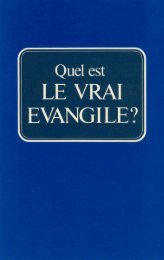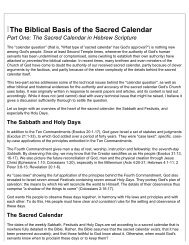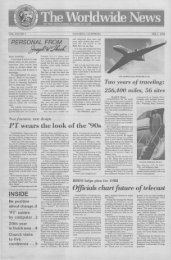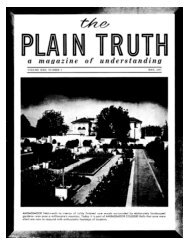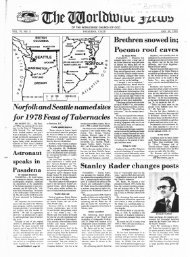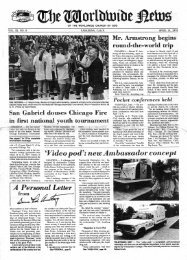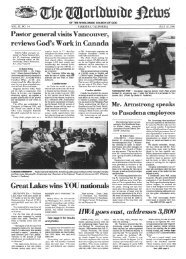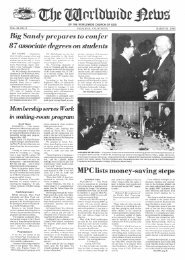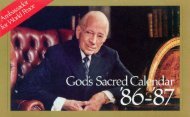Plain Truth 1958 (Vol XXIII No 01) Jan - Herbert W. Armstrong ...
Plain Truth 1958 (Vol XXIII No 01) Jan - Herbert W. Armstrong ...
Plain Truth 1958 (Vol XXIII No 01) Jan - Herbert W. Armstrong ...
Create successful ePaper yourself
Turn your PDF publications into a flip-book with our unique Google optimized e-Paper software.
<strong>Jan</strong>uary, <strong>1958</strong><br />
The PLAIN TRUTH Page 21<br />
message‘ When 98% of people do not<br />
understand your words, they do not receive<br />
your message. They only become<br />
confiised and turn to something interesting.<br />
“Use only plain, simple words. Use<br />
words that even readers of no more than<br />
a third or fourth grade education can<br />
UNDERSTAND. Try to achieve good literary<br />
quality with a large vocabulary of<br />
common, simple words, and by the<br />
manner in which you weave those words<br />
into the sentence structure.”<br />
Immediately my vocabulary underwent<br />
an overhauling. Deliberately I began<br />
dropping out of my speaking and<br />
writing vocabulary all the big words not<br />
in common use. Every person has three<br />
vocabularies: smallest of all, his speaking<br />
vocabulary, consisting of the fund of<br />
words with which he is able to speak<br />
readily; next larger, his writing vocabulary;<br />
and largest, his reading or listening<br />
vocabulary. Everyone can understand<br />
many words which he may read, or hear<br />
spoken by others, which he could not<br />
readily use himself in conversation.<br />
My effort, then, became that of developing<br />
ability to use the largest variety<br />
of words readily comprehensible by most<br />
people when heard or read.<br />
But effective writing is far more than<br />
memorizing a store of words. It is the<br />
manner in which those words are put<br />
together in sentence structure that determines<br />
effectiveness. So I was taught<br />
to study the matter of STYLE in writing.<br />
Immediately I set out to develop an<br />
effective style. It had to be fast-moving,<br />
vigorous, yet simple, interesting, making<br />
the message plain and UNDERSTAND-<br />
ABLE.<br />
All this advertising instruction was<br />
the most valuable possible training for<br />
the real mission in life to which I was<br />
later to be called-God’s ministry. It<br />
was a training such as one could never<br />
receive in any theological seminary. It<br />
was the most practical training for<br />
preaching, as well as for writing Gospel<br />
messages.<br />
Some preachers seem to think they<br />
impress their congregations by their<br />
ability to use big words beyond the comprehension<br />
of the audience. Others succumb<br />
to the temptation to become too<br />
“scholarly,” speaking over the minds of<br />
their hearers-but never plainly into<br />
their minds so as to reach their hearts.<br />
The same rules that attract attention,<br />
arouse interest, win conviction and stir<br />
emotions or hearts to action in advertising<br />
accomplish the same results in<br />
preaching.<br />
Another most important principle-I<br />
was taught to avoid the academic “outline”<br />
form of presentation. This is the<br />
manner in which nearly all ministers are<br />
taught in seminaries to organize their<br />
sermons. This is the one, two, three, a),<br />
b), c) form of outline. It is orderly and<br />
precise, but dull, dry, uninteresting to<br />
the congregation. Ministers using this<br />
type of presentation must limit their<br />
sermons to 20 or 25 minutes in church,<br />
or 5 to 15 minutes on the air. If these<br />
sermons were not surrounded by an<br />
elaborate program of music, ceremony<br />
and pomp, few if any would come to<br />
hear them. You hear a half-hour religious<br />
broadcast starting out with choir<br />
singing of hymns, then possibly a male<br />
quartette, and finally a 5 to 15-minute<br />
sermon during which a large portion of<br />
listeners tune to something else. Or, a<br />
whole hour broadcast in which the first<br />
35 minutes is devoted to a program of<br />
music and reading of letters, with a 15<br />
to 20-minute sermon following in the<br />
second half-hour.<br />
The Way It’s Usually Done<br />
The customary form of sermon<br />
presentation, as taught in theological<br />
schools, seems to be something like this:<br />
First, reading a single verse from the<br />
Bible-perhaps it is only a part of a<br />
sentence in between two commas-but<br />
the thought makes no difference. The<br />
verse is read only because it happens to<br />
contain a certain word. This word is the<br />
SUBJEC‘I’ of the sermon. The word might<br />
be “endurance.” After reading this<br />
“text,” the minister will say something<br />
like this:<br />
“My subject this morning is “Endurance.”<br />
There are four kinds of enduraricc.<br />
<strong>No</strong>w, first, . . .” and he proceeds to<br />
expound what he has outlined so systematically<br />
under Roman numeral I.<br />
Under this he may modify this kind of<br />
endurance under capital letters A, B, and<br />
C, with more subdivisions of small 1, 2,<br />
and 3 undcr that. There is no connection<br />
whatever between his first category of<br />
endurance and his second, but next he<br />
<strong>No</strong>s place anunciar que ofrecemos laa<br />
siguentes obras:<br />
LAZAR0 y el RICO<br />
PREDESTINACION-;La enseia la<br />
I Biblia?<br />
iCuLl es el Dia de REPOSO del<br />
Nuevo Testamento?<br />
iLa Verdad acerca de la NAVIDAD!<br />
Dirijase a1 Departamento de Espaiiol,<br />
proceeds to Roman numeral 11, then 111,<br />
and finally, when the audience has lost<br />
interest he hastens to say, “<strong>No</strong>w fidly,<br />
and briefly,” as he proceeds to Roman<br />
numeral IV.<br />
But in writing advertising, Mr. Boreman<br />
taught me always to tell a stofy-to<br />
make it interesting-and to tell it in<br />
story form. That is, first, put a question<br />
in the minds of readers they really want<br />
answered-or make a statement that is<br />
so unusual it either raises a question in<br />
the readers’ minds, or challenges them to<br />
demand an explanation and want to read<br />
on to get it. It must arouse instant k.<br />
terest. It must create suspense/ Litre a<br />
mystery play, it must not tell the rwdct<br />
the answer at the beginning. It mwt develop,<br />
rapidly, lucidly, increasing the<br />
interest, toward the final solution <strong>01</strong><br />
answer. It must HOLD the interest unril<br />
the story is told.<br />
These same principles apply to a<br />
spoken sermon, or a Gospel-Message<br />
advertisement. The headline: “WHY<br />
Does God Allow WarJ?” followed immediately<br />
by a slightly smaller-type subhead<br />
saying: “If God is all-merciful, he<br />
wouldn’t want humans to sder so,<br />
would He? And if God is all-powerful,<br />
He could stop all this anguish. Then<br />
why doesn’t He?’-this advertising<br />
head-line, or the same words at the beginning<br />
of a sermon or a broadcast,<br />
makes people say either: “I’ve always<br />
wondered about that!” or, “I never<br />
thought of that-say, that’s interesthg-<br />
I want to know the answer!!” I have<br />
used this very beginning, in a full-page<br />
ad, in evangelistic sermons, and in the<br />
broadcast-and it has succeeded in getting<br />
the attention, arousing intsrmt, and<br />
creating Jusfelzse to read on or listen<br />
thru, of MILLIONS of people!<br />
I was taught in those early days to put<br />
a story flow into the text of an advertisement,<br />
holding the interest of readers<br />
I




